2013 Scion FR-S / Subaru Essex AP Racing Competition Brake System (Sprint) - Bundle #CP8350-25S4L
The Essex Competition Brake System (Sprint) utilizes AP Racing's CP8350 caliper. How many features from the best racing calipers in the world can you cram into a $500 caliper? Probably more than you ever thought possible. AP Racing’s CP8350 was designed to be the market leader in performance and features while maintaining a wallet-friendly price point. AP’s newest design brings real racing technology like stainless steel pistons, anti-knockback springs, and integrated hydraulic protection to the average enthusiast at lower prices than the competition charges for watered-down street components. Incredibly, this is achieved while maintaining an unloaded weight of only 4.8 lbs. The CP8350 completely redefines the content/cost ratio among aftermarket brake calipers.
Check out this video from Dezoris @ FT86Club:
Detailed Description
The Toyobaru collaboration was one of the most anticipated enthusiast
cars of the past decade. Teasers and tidbits trickled in for years,
hinting at the potential of what was to come. The final product seems
to have actually delivered on the hype, and a diverse range of sportscar
fans are now flocking to these cars. Most enthusiasts view these cars
as a fantastic platform to develop for track days and racing.
These cars were designed from the ground up as a pure sports car.
Light weight, front engine, and rear drive all combine to offer a great
driving experience on the street. On track with sticky tires, they're
laying down lap times on par with what are supposed to be much faster
cars. These cars were also designed with the aftermarket in mind. Many
features of the car are rather basic to keep costs down, and the brakes
are one of those areas. They're heavy, not particularly attractive,
and leave a lot of performance on the table when track temperatures
soar.
Not all brake systems are created equal. In fact, most “big brake
kits” aren’t really suited towards heavy track use either. While they
[usually] increase thermal capacity and may solve small fading issues,
they generally aren’t optimized for hardcore track use. We set out to
design a couple of brake packages that can take anything thrown at
them...and then some.
Let’s take a look at how the Essex/AP Racing Sprint Competition Brake System sets itself apart from the crowd.
Calipers- AP Racing CP8350 Four Piston Forged

Let's first take a look at the calipers. They are one of the most critical pieces of the system.
20mm Thick, Inexpensive Brake Pads
Race pads aren’t cheap, and you burn through them quickly if you
spend any amount of time on track. One of the great things about our
Sprint and Endurance systems are the huge range of pad choice. The AP
Racing CP8350 calipers in these systems use a pad shape that is
available in just about every pad compound under the sun from all of
the major manufacturers (Essex alone sells close to 20!). That means
you’ll never end up in a pinch for a track weekend without pads. The
average set of race pads for the front OEM BRZ calipers typically range
from $200-$250, while the average set for the AP Racing CP8350 costs
$175. How many sets of brake pads do you go through in a season? Some
people find that they could pay off their brake system in a short
period of time on pad savings alone.
Cheap, thick, and always available is a great combination for a
consumable like race pads. You can see the full list of pads we sell
for these calipers on our CP8350 page. For the Sprint system, you'll need to stick with a pad that has a radial depth of 43mm or less.
Pad Comparison: Sprint, Endurance, and USDM OEM BRZ
Below are some photos that show the differences between the Sprint, Endurance, and FR-S / BRZ OEM brake pad shapes.
- On the left is the pad used with our Sprint system. The
particular Ferodo pad shown has a radial depth (height of the
friction puck) of 41mm, although a depth of up to 43mm is useable with
the Sprint system.
- The pad in the center is a 50mm radial depth Ferodo pad, which
can be used with our Endurance system. This is possible because
the discs used in the Endurance system have a greater radial depth
(taller disc face).
- The pad on the right is the USDM OEM front BRZ pad.
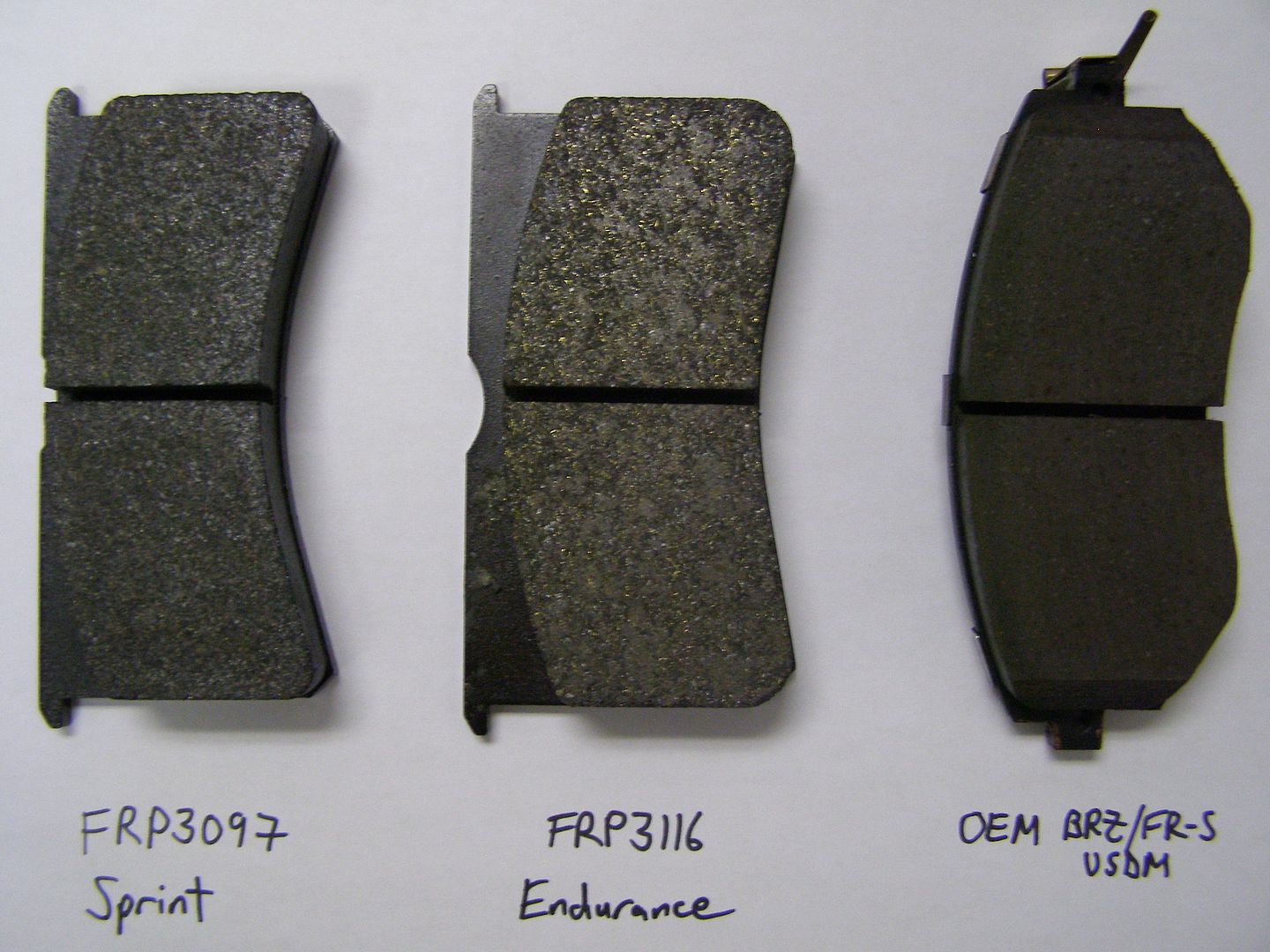
You can see in the pictures that the pad faces of the Endurance and
OEM pads have almost identical surface area, while the Sprint pads are
slightly narrower. Many people mistakenly put too much emphasis on pad
surface area. While surface area is an important factor in overall
system design, the bigger news is pad volume.
Volume is the length x width x thickness of the pad, and determines
how large of a heat sink the pad is. The friction puck (the material
attached to the backing plate) on the Sprint and Endurance pads is
roughly 15mm thick, while the puck on the OEM pads is roughly 10mm
thick. That extra 5mm of thickness provides a huge pad volume increase,
which is one of the factors that provides additional thermal capacity
in the brake system. Think of the pad as a barrier between the brake
disc and the caliper pistons. All else held equal, a thicker pad
provides more material for heat to spread into and dissipate. The
thicker pad will do a better job of insulating the pistons from disc
heat (less chance of fade-related issues), and will also wear longer
(less frequent pad replacements and lower running costs).
15mm thick friction puck on the pads for our brake systems

The OEM pad friction puck is only 10mm thick
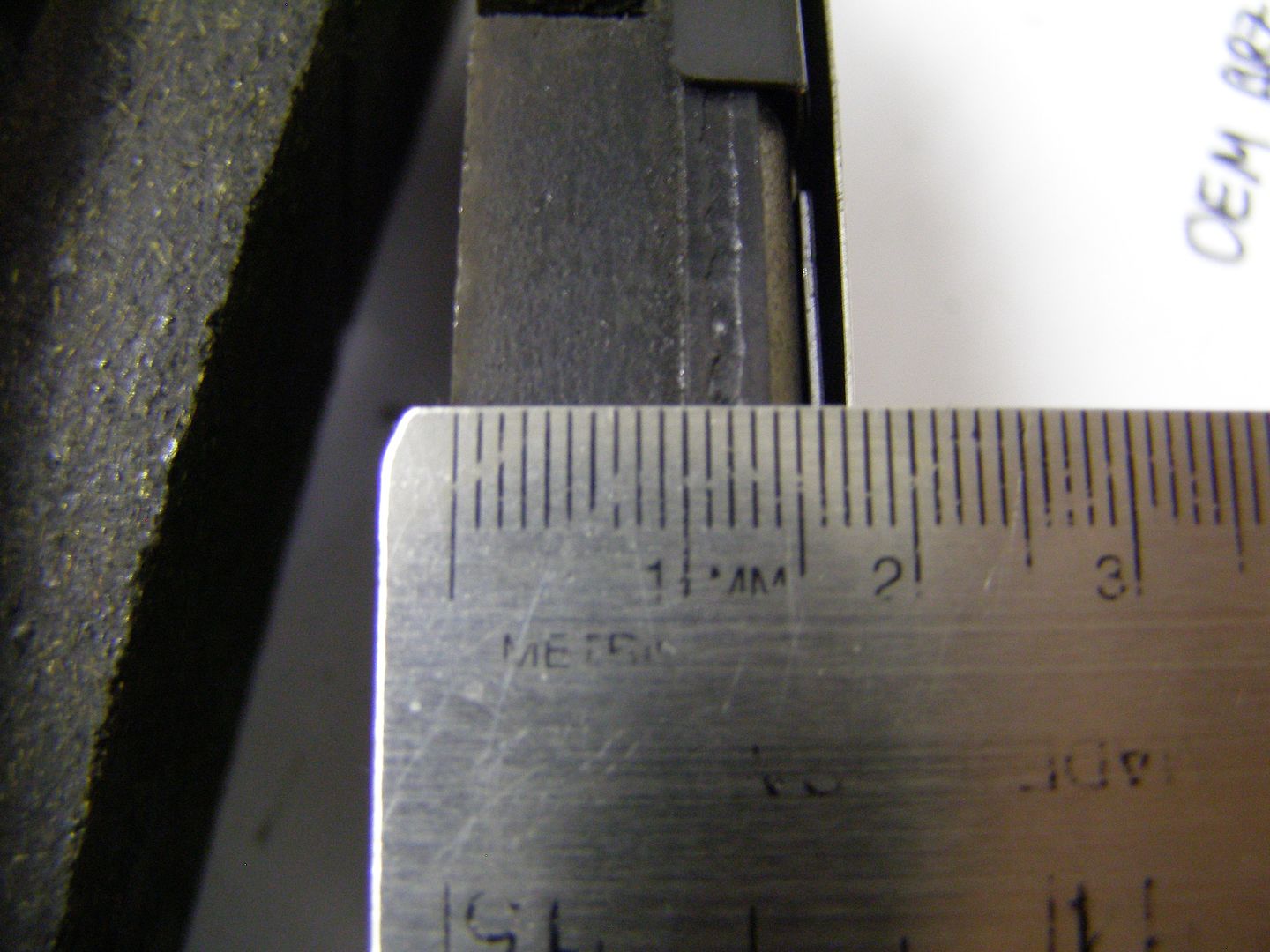
Pistons
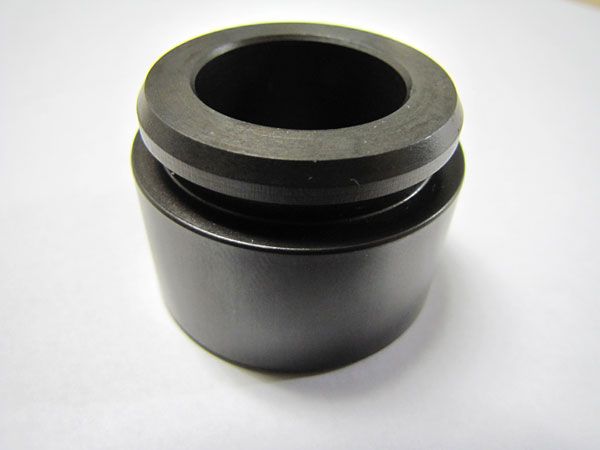
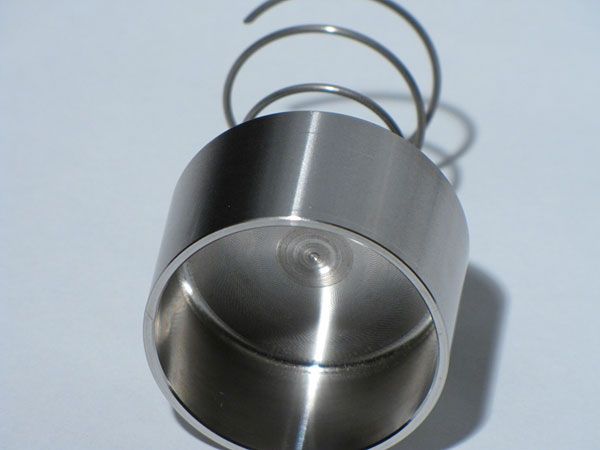
Aluminum piston vs. AP Racing machined stainless steel piston
There are people out there who will tell you that aluminum pistons
are great for track calipers. They will tell you that the expansion
rates of the pistons and caliper body need to be the same when heated.
This argument is completely invalid and unproven. Those same people
tend to get upset when you point out the fact that every serious race
caliper, from every serious race caliper manufacturer on the planet uses
either stainless or titanium pistons, period. There is a reason for
this: they work better!
Stainless steel pistons are far superior to aluminum pistons in
creating a thermal barrier. They are much better at keeping heat out of
your brake fluid and preventing a soft pedal from fluid fade on the
track. This has been proven over and over again at all levels of
motorsport. Don’t fight it, just accept it.
While the most aftermarket calipers uses a pressed aluminum piston,
the CP8350 uses an expensive machined stainless steel piston. As
discussed above, this is to slow and repel the influx of heat into the
brake fluid.
Anti-knockback Springs
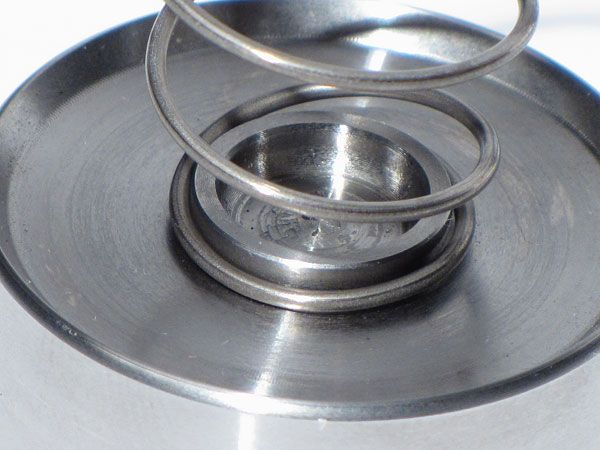
Not only are the pistons stainless steel, they are fitted with
anti-knockback springs. Springs in pistons you ask? Yes, springs. If
you’ve ever gone through a series of S turns and then had your pedal
drop when going into the following brake zone, you have experienced
knockback. To say it is disconcerting is an understatement. You’ll
often see pro drivers ‘pre-tap’ their brakes lightly when approaching a
brake zone. They are fighting knockback.
Knockback is a phenomenon that is common with fixed calipers.
Knockback occurs when your car’s wheel, hub, and bearings deflect during
cornering, allowing your brake disc to move out of sync with your
caliper and brake pads. The caliper is less prone to movement because
it is attached to the more rigid upright. As the brake disc deflects,
it actually pushes the pads away from each other, forcing the caliper
pistons back into their bores. The piston seals don’t have enough
tension in them to return the pistons to their original location. That
means there is slack in the system that needs to be taken up. When you
press the brake pedal, it will continue to drop until that slack is
taken up.
Anti-knockback springs help alleviate this situation by putting some
tension on the back side of the pistons. When the disc deflects and
pushes the pistons, the springs push the pistons back into their proper
location, reducing slack in the system. That means less pedal drop and
far fewer pucker-factor moments when going into heavy brake zones.
Since the springs are only 4 lbs., and the seals in the calipers are
specially designed to minimize brake drag, you won't see any negative
impact on pad or disc wear.
Integrated Hydraulic Protection
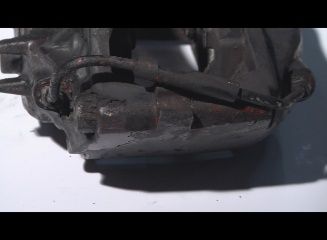
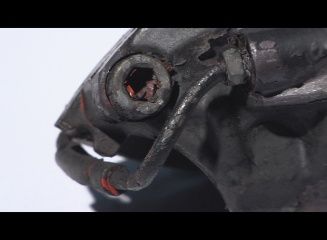
Pictured above is a set of calipers we pulled from a car we were
testing (Lancer Evo). We saw that the right hand caliper had a bent
crossover pipe. Most likely it was bent when a wheel was being
installed. Or, it could have been hit by a piece of track debris.
Regardless of how it happened, this is precisely the type of damage the
CP8350 was designed to prevent.
On the CP8350 the bleed screws and crossover pipe are hidden in
little coves that protect them from contact. If you frequently pull
your wheels on and off your car, you probably know how easy it is to
bump your caliper with then inner barrel of the wheel. How easy would
it be to ruin your weekend if you happened to knock off a bleed screw
and kill your caliper? The integrated protection on the CP8350 will
prevent anxiety the next time your friend is putting your wheel back on
and you hear that dreaded ‘clunk.’
Also, there’s no need to worry about access to the bleed screws.
Fitting a box end wrench on the bleed screw when bleeding isn’t an
issue.
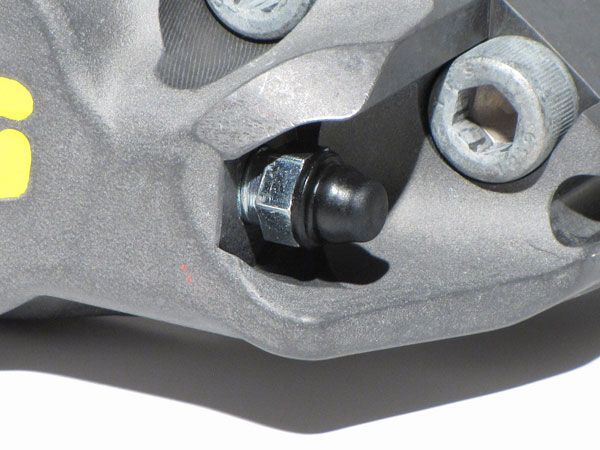
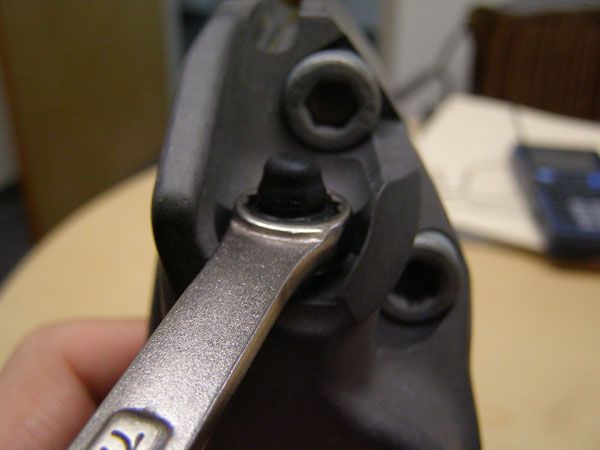
High Temperature, Low Drag Seals without Dust Boots
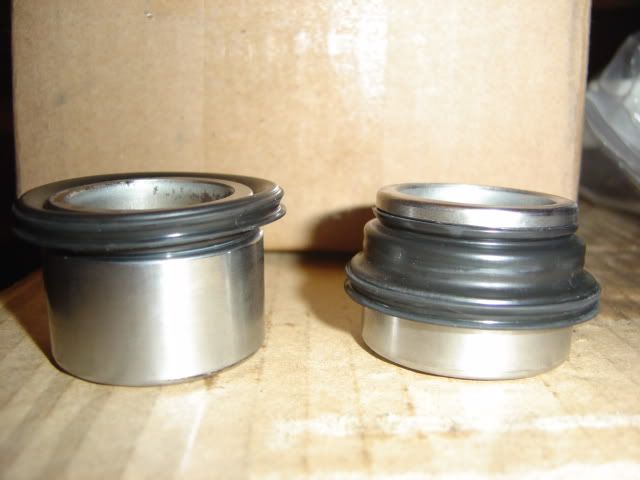
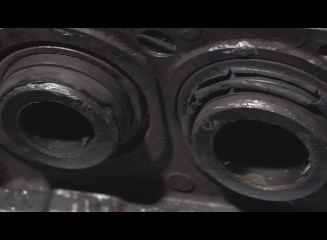
Dust boots and the track just don't mix very well
Most aftermarket calipers are designed for year round road use and as
such come with a bellows style external dust seal. “So?” You ask.
Well, we’ve seen them burn up in a single 20 minute session, and all
they do is make a big mess. They usually look something like the above
pics before and after track use.
Additionally, the OEM caliper seals aren’t designed to handle
repeated trips to several hundred degrees without becoming brittle and
leaking, etc. On the other hand, the CP8350 caliper has the exact same
AP Racing high temperature seals used in NASCAR Sprint Cup, ALMS, DTM,
etc. They are designed to operate at extreme temperatures without
leaking, and require less frequent replacement and servicing. You won’t
see a ragged mess here.
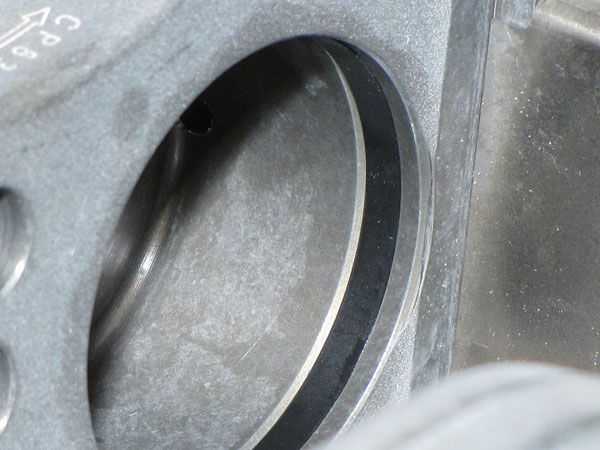
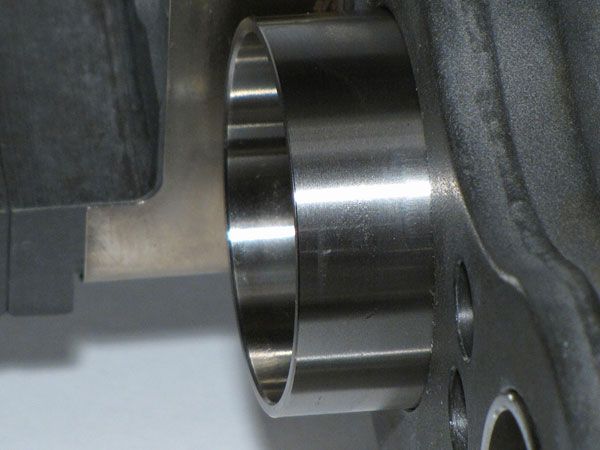
Simple Pad Change with One Bolt
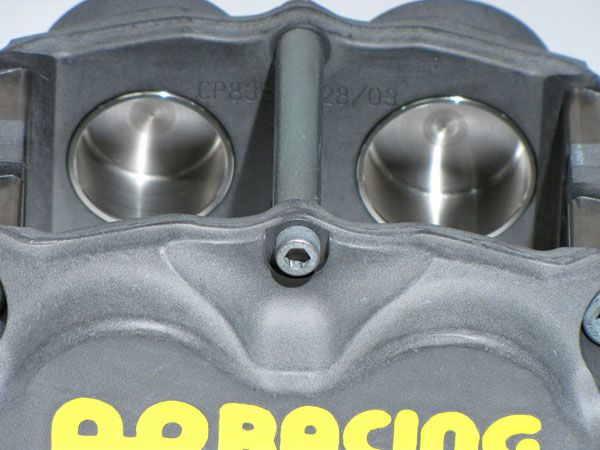
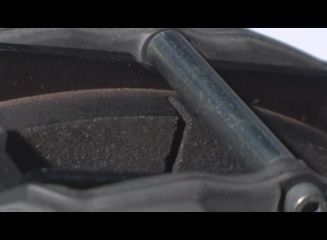
After the countless times you’ve changed your brake pads, you’re
probably never too excited when it comes time to do so. Changing pads
will no longer be a chore with the CP8350. No more pulling your OEM
caliper off every time you want to swap apds. AP’s bridge bolt pops out
easily with a 5mm hex wrench and a 7mm socket. It will take you
longer to pull off the wheel than it will to change pads. Less time
futzing around in the paddock, and more time driving= fun.
Pistons Sized Specifically for the BRZ / FR-S / GT86
The piston sizes for our system were specifically chosen for the
FT86 platform, and have very little impact on the front to rear brake
bias. That means our front system can be bolted to an otherwise stock
brake system with no ill-effects, negative impact on ABS, etc. The
vehicles stock master cylinder can remain, as can the OEM rear brake
system.
Compact, Ultra-lightweight Package
Our brake system follows a simple philosophy: Anything larger than
necessary to get the job done is simply dead weight to drag around.
If you’re worried about the loss of stiffness due to mass reduction,
don’t. AP’s CP8350 is an extremely stiff, forged design, and the pedal
feels rock hard on the FT86.
With pads and bracket, it weighs several pounds less than the OEM
calipers! That’s less unsprung weight per corner to drag around. For
the competitive individual, weight savings often becomes the holy grail
of modifications. A lighter car means greater acceleration, superior
handling, and less mass to bring to a halt. On a relatively low-powered
car such as the FT86, this becomes even more important. At some point
reducing weight becomes extremely expensive on a dollar per pound
basis. When viewed in this manner, our system becomes an even greater
bargain.
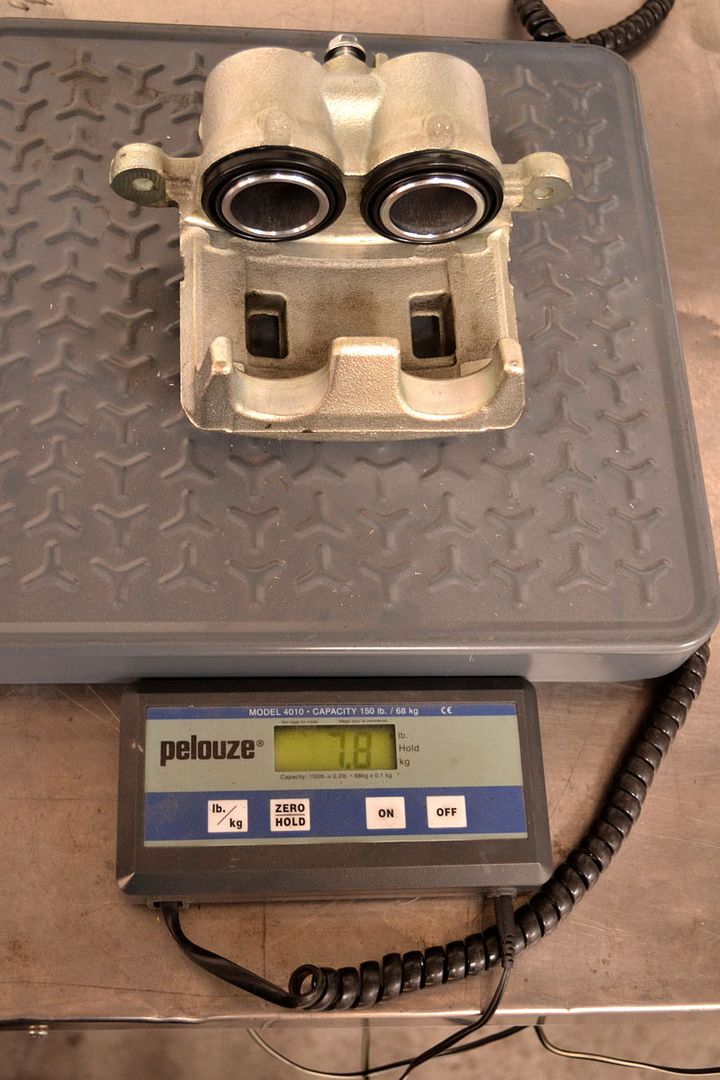
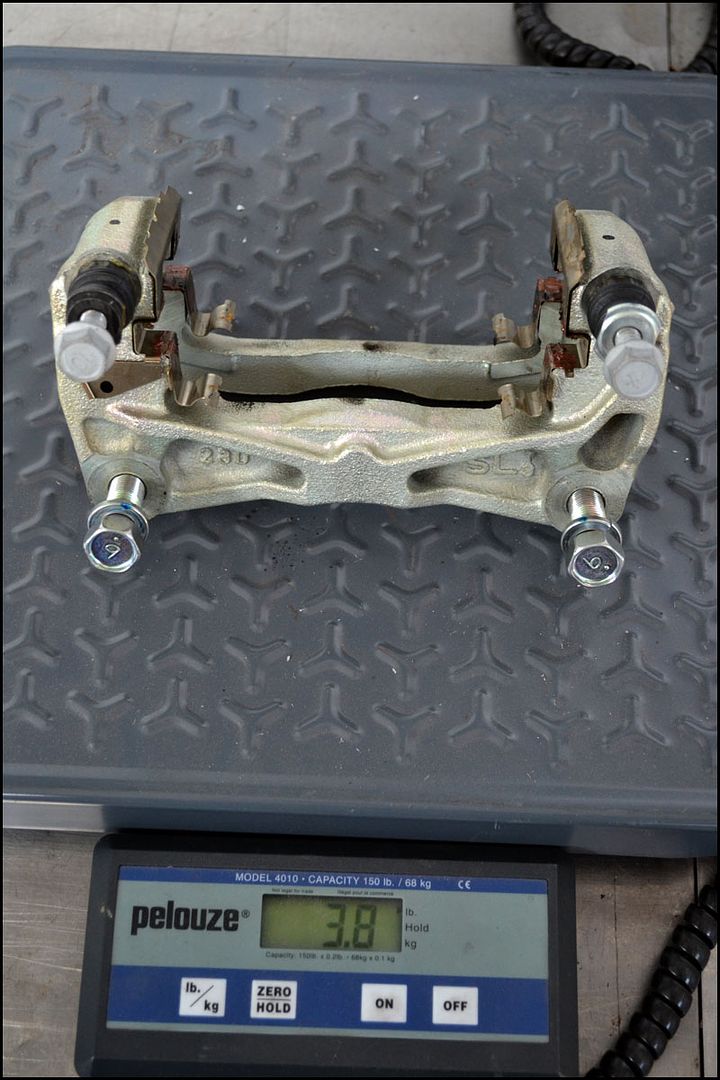
OEM caliper & bracket = 11.6 lbs.
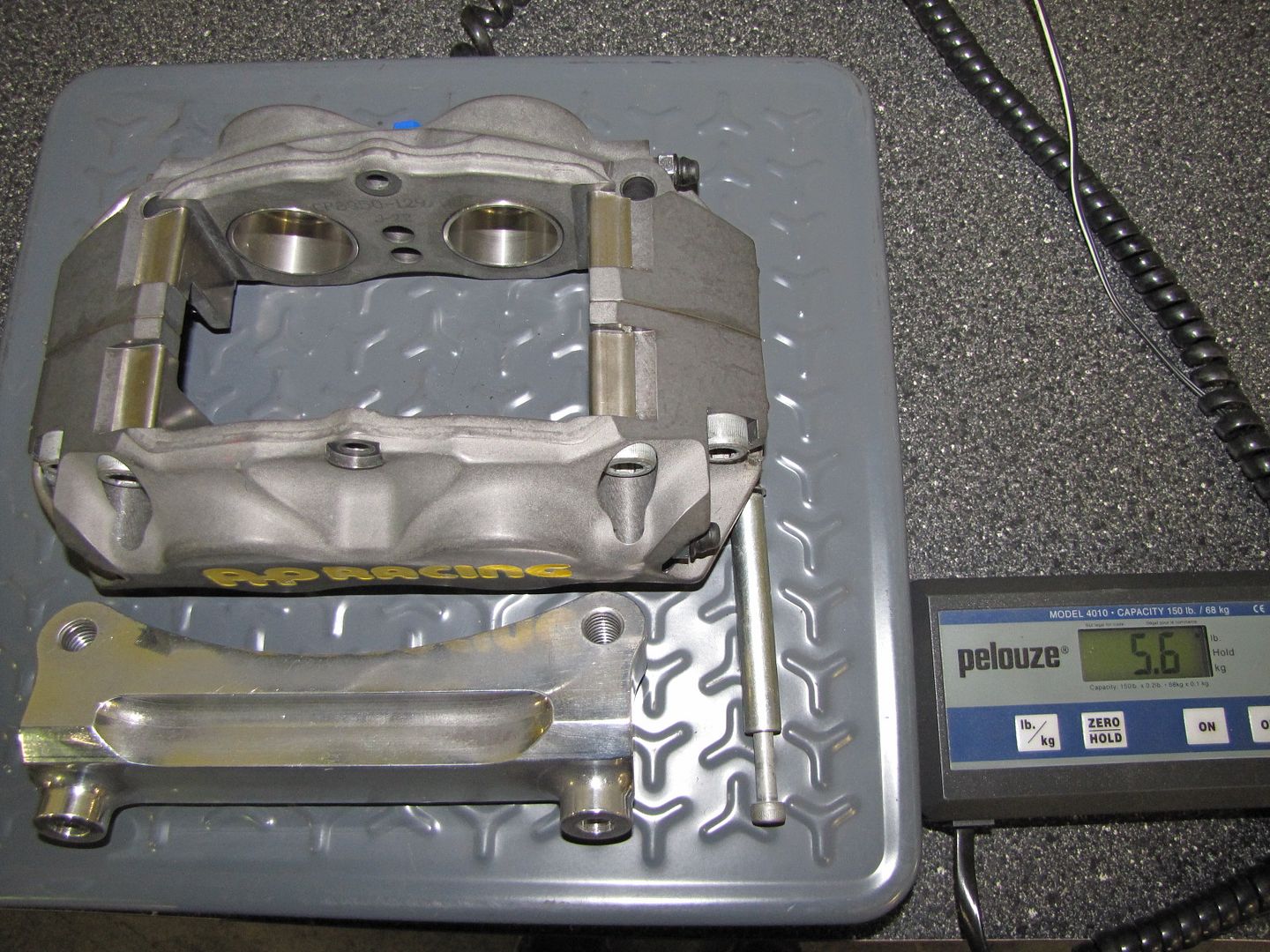
CP8350 and Lancer Evo bracket shown above (FR-S bracket will weigh almost the same) = 5.6 lbs.
Lifetime Professional Reconditioning Service
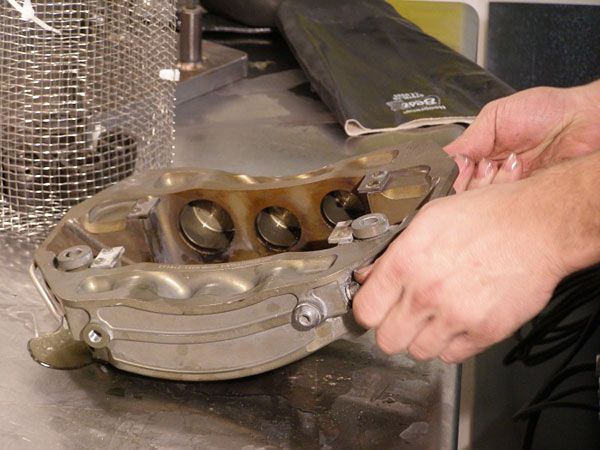
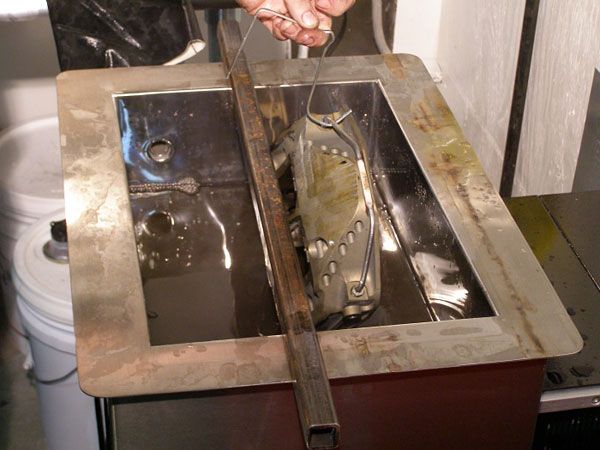
Essex is AP Racing's official North American caliper reconditioning
center. We have skilled service technicians rebuilding hundreds of AP
Racing calipers each year for the top teams in NASCAR Sprint Cup, ALMS,
etc.
Ultrasonic cleaning:
After passing the hardness test, your calipers will be placed in an
ultrasonic cleaner to remove all dirt, debris, brake fluid, etc. This
method produces results that are far superior to what the average racer
could accomplish via hand-cleaning.
Inspection and re-assembly:
All serviceable parts of the caliper will be inspected and replaced if
necessary, including the seals, abutment plates, pistons, and bleed
screws.
Cyclical Pressure Testing:
After your calipers have been rebuilt, they will be cycled at high and
low pressure on a pressure bench to ensure proper functioning. This is
important, as certain leaks only show up under specific pressure
conditions.
Price: The labor
price to rebuild a CP8350 is $78 per caliper. That does not include
parts. Assuming there has been no damage to the caliper, Essex
typically recommends replacing the seals ($40) and bleed screws ($15)
during the standard reconditioning process. For roughly $125, you can
have a fresh, professionally serviced caliper in peak operating
condition.
Finish
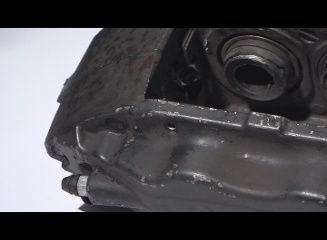
Most aftermarket calipers come in a painted finish, whether they are
red, black, or gold. The painted finish is for corrosion resistance and
appearance.
Unfortunately, for all of the compliments pretty gold calipers
generate, there is an associated price if you drive the car in a track
environment. That price is the chipping, flaking, fading, color shift,
and general decimation of the finish in a fairly short period of time.
We’ve seen painted OEM and aftermarket calipers go from the as-delivered
color to a nasty shade of brown in as little as one weekend. While
this is typically worn as a badge of honor among our more hardcore
customers, let’s face it…they still look terrible. More importantly
though, all of those bits of paint end up in places they’re not supposed
to, which I’ll get to in a minute.
Why does this happen? Heat. Paint and powder coat cannot adequately
handle the temperatures that calipers hit when run on a track. Powder
coat also has some notorious issues with shrinkage. The powder coat
layer expands and grows when the caliper is heated. When it cools
however, the powder coat doesn’t necessarily shrink in step with the
caliper body itself. What’s left is a loose shell of finish hanging
limply on the caliper body. That shell then cracks and falls to pieces.
Paint can also have similar issues depending on how it is applied.
If you were to line up a few aftermarket calipers from the same
manufacturer, you would likely see that the painted finish on each of
those calipers is slightly different. Some have a thicker coat, some
thinner, slightly different shades of red, etc. Painting is to some
extent an art form, and must be performed in a tightly controlled
environment. If it isn’t, you’re always going to see variation. A
thick coat makes the part look soft around the edges, and is prone to
cracking off in the same manner as the powder coat described above,
leaving the underlying finish exposed. A part without enough paint will
look uneven, and will not protect the underlying aluminum particularly
well either.
In addition to problems with cracking, flaking, and uneven
application, paint and powder coat also experience extreme color shift
when heated. Red becomes maroon or black, gold becomes brown, and black
just gets uglier.
Now let’s take a look at some real racing calipers.
The caliper we're using in our Essex Competition Brake Systems is the
AP Racing CP8350. This caliper was designed to be ultra-lightweight,
stiff, and durable under all track conditions. The finish we chose is a
hard anodizing. Hard anodizing is the business under track conditions.
When raw aluminum reacts with the oxygen in the air, a hard surface
film develops on aluminum which prevents further degradation. The
process is called oxidation, and you can think of it like rust. The
anodizing process leverages this natural phenomenon, and takes it a step
further to produce an extremely hard protective layer of aluminum oxide
on the aluminum. It does so by running an electrical current through
an acid bath, and dying it to the desired color. If you want to know
more, Google it.
The result is a finish that is far more appropriate for racetrack
use. Anodizing creates a uniform surface that is much more abrasion
resistant than paint or powder coat. That means if you ding an anodized
caliper with a box wrench when bleeding it, a big chunk of the finish
isn’t going to chip off into your hand. While anodized calipers will
still exhibit minor color shift, it will take a lot more heat to get
them to change, and they won’t change as dramatically. They will go
from semi-ugly grey, to a semi-ugly grey-brown (see below). In short,
they’ll look like the race calipers they are. More importantly though,
you aren’t going to have bits of anodizing sticking to the sides of your
pistons.
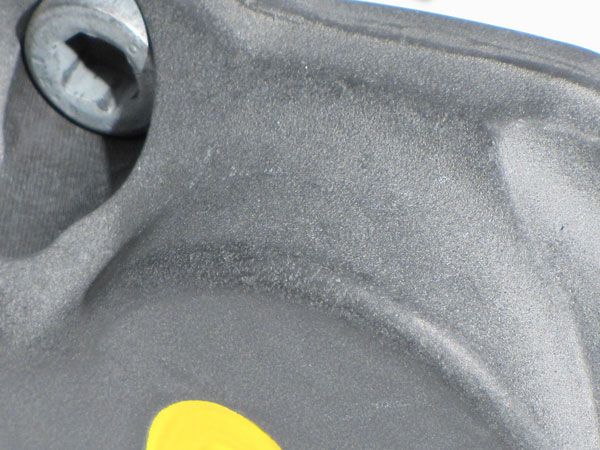

Please do keep in mind however, that every yellow AP logo is hand
painted on the caliper. It will degrade over time, particularly if you
slop brake fluid all over it. Our customers asked us for something with
at least a little visual punch and some brand recognition, so we had to
offer them this token. Also keep in mind that an anodized finish is
not designed to be driven through road salt.
Okay, so we’ve established that paint and powder coat are not ideal
choices for calipers that will be thrashed at several hundred degrees on
the track. While the finish is the most blatant feature that people
key in on, it’s actually not nearly as important as some of the other
features in the caliper that allow it to operate efficiently at track
temperatures.
Discs- AP Racing CP3862 Heavy Duty J Hook Racing
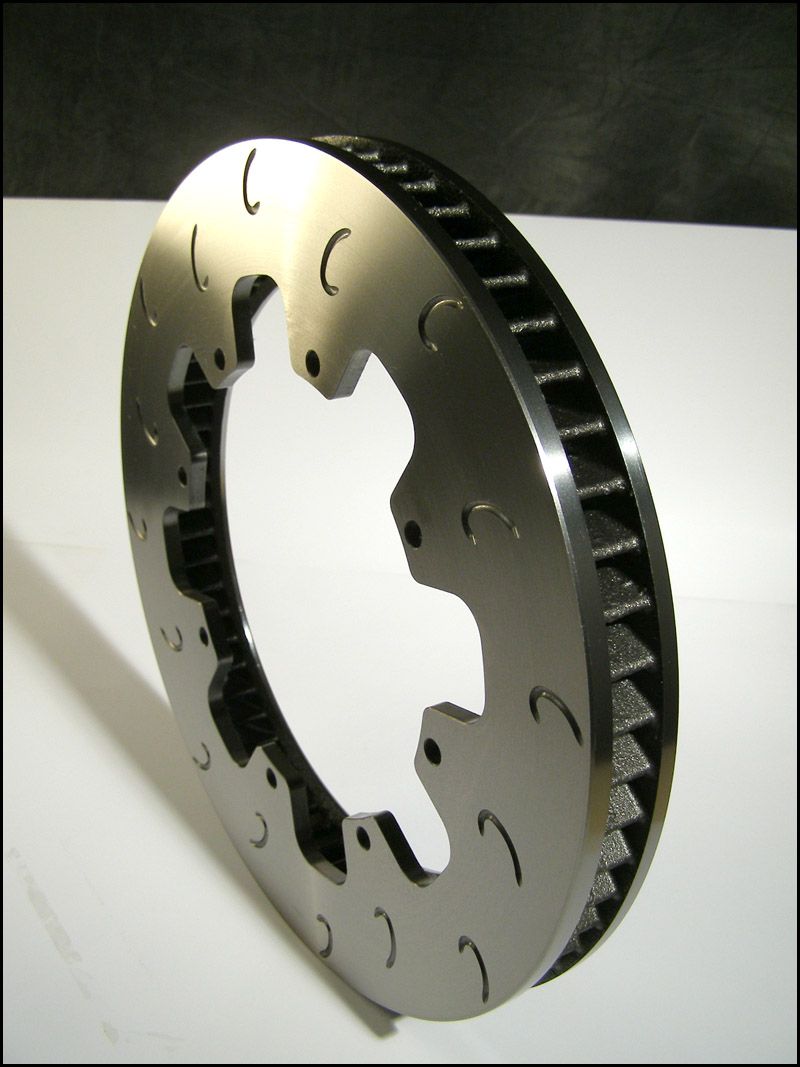
Width and Thermal Mass
One of the primary goals with a brake disc is to put the mass of the
disc where it counts. The area of the disc that is swept by the pads
is where the most heat will enter the disc, and that area's design is
critical in determining how heat will flow through and out of the
disc. With the OEM discs, much of the disc's mass is located in the
hat portion, near the hub of the car. Having a mass of hot iron in
that area isn't particularly beneficial to lowering brake temps, and
also adds wear and tear on your wheel bearings, etc. With an
aftermarket two-piece disc, almost all of the disc's mass is located in
the swept region, which is where it can absorb and radiate heat
through the disc's vanes. Therefore, two discs of roughly the
same overall dimensions on paper can have tremendously different
capabilities to absorb and transfer brake energy into heat.
The CP3862 is 299mm x 32mm. By using a relatively small diameter
disc that is wider, we can gain the thermal mass we need without
requiring large diameter wheels. We go from an OEM 24mm wide disc to a
32mm disc. We now have a beautiful wide air gap to flow a ton of air.
We also maintain a lower moment of inertia. Essentially what that
means is, a smaller diameter disc has its weight distributed more
closely to the center axis around which it spins(hub), and is easier to
accelerate than a larger diameter disc of equal mass.
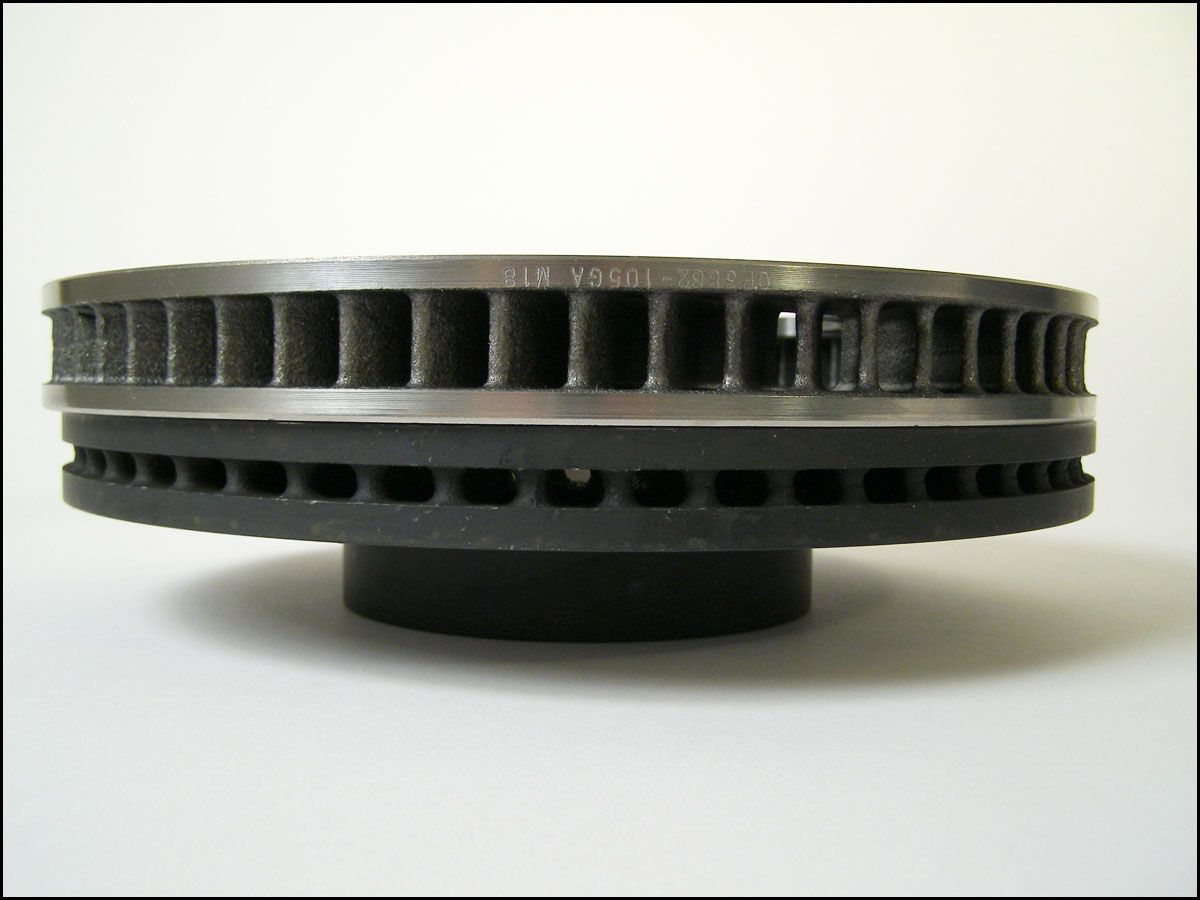
Which of these do you think will flow more air?
OEM BRZ disc air gap
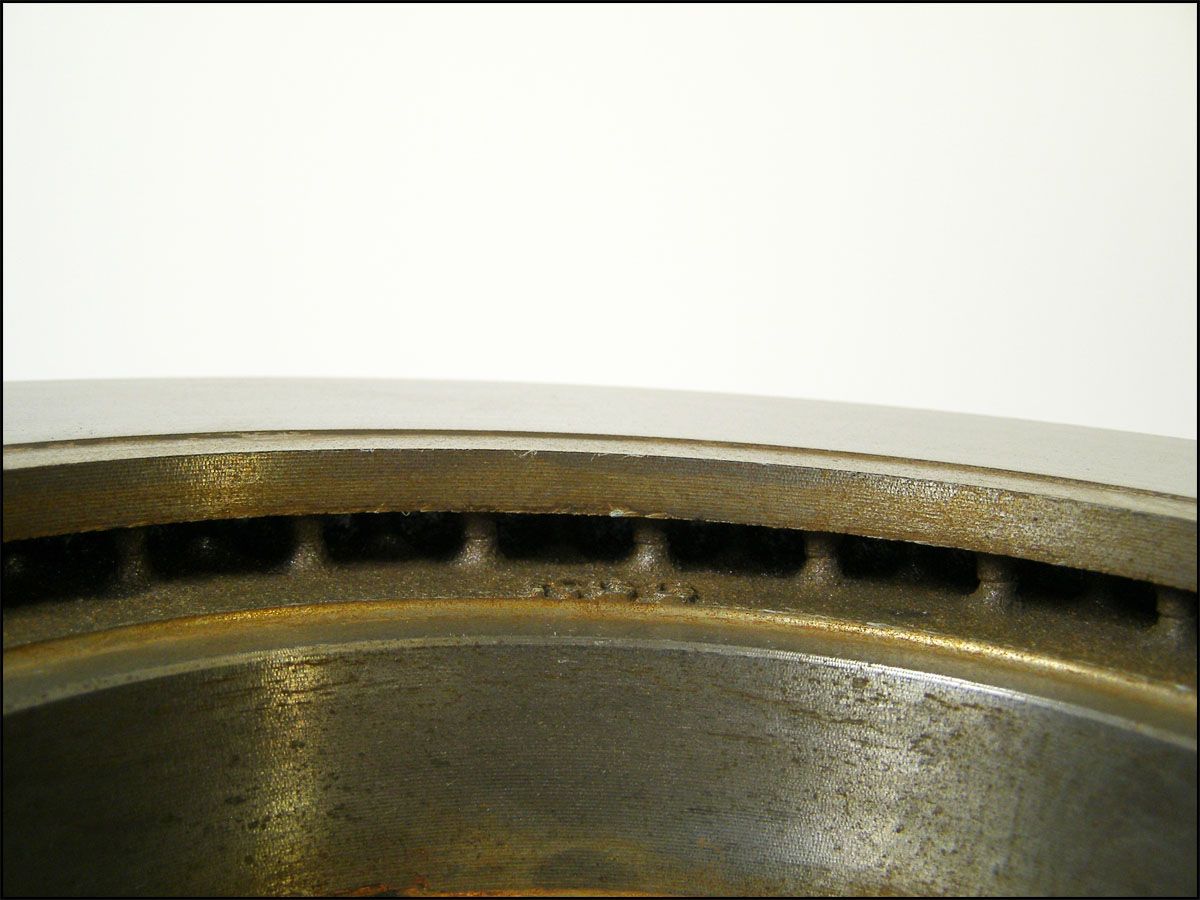
or...CP3862 air gap
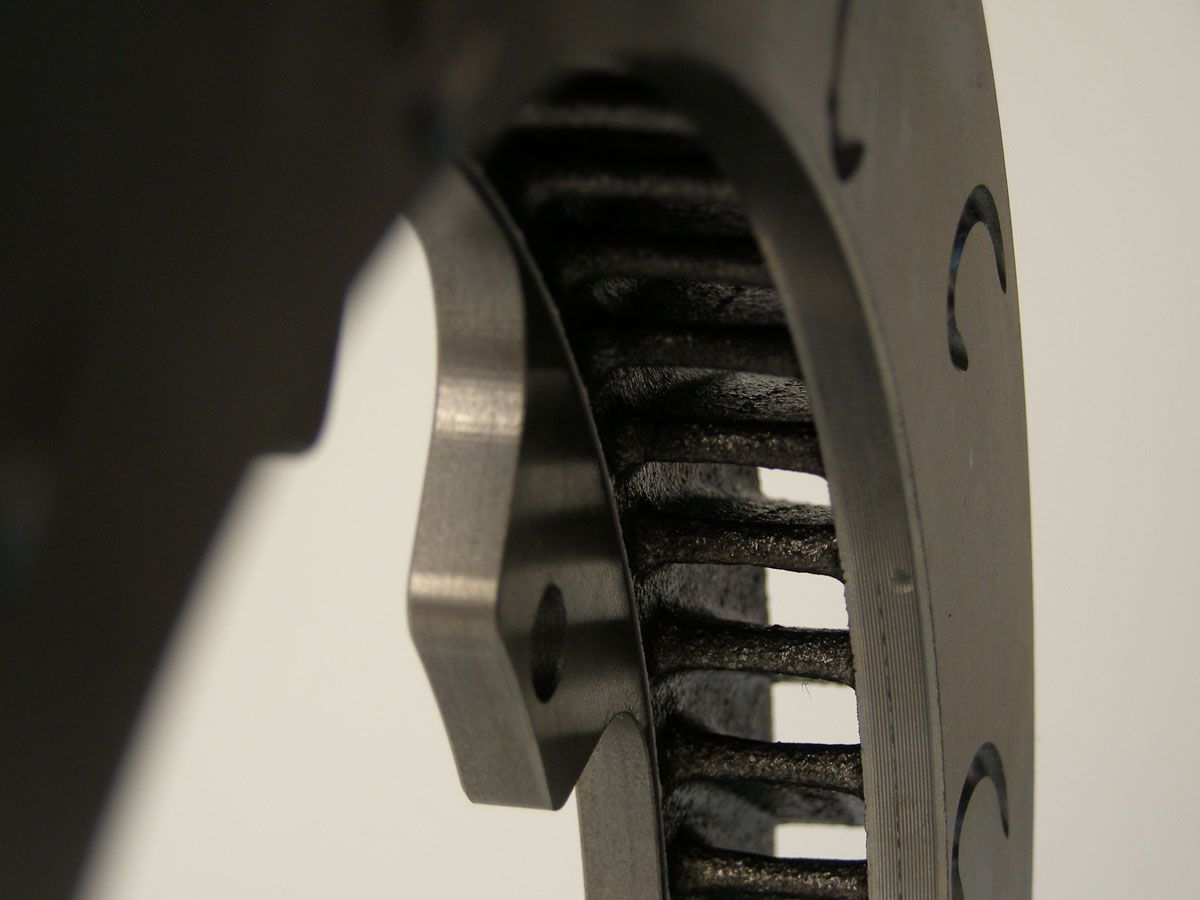
Vane Design
The internal vane design on AP’s CP3862 is quite a bit different vs.
the OEM discs. After extensive CFD and thermal stress analysis, AP
designed the Heavy Duty J Hook with 60 curved vanes and a wide air gap
to increase airspeed and heat transfer, while reducing deflection and
remaining reasonably lightweight. The increased directional vane count
on the J Hook Heavy Duty Disc amplifies air speed through the disc,
reduces air recirculation between vents, and also increases convective
heat transfer and heat distribution. In other words, both air and heat
move more quickly and evenly through the disc, creating increased
stability under the extreme loads of racetrack use. The disc is less
prone to coning, distortion, and cracking than the OEM disc, while
providing less brake fade, reduced judder, and a longer service life.
Weight
The weight difference between the AP Racing CP3862 and the OEM front
disc is glaring. The CP3862 weighs in at svelte 12.2 lbs. with hat,
while the OEM front disc is a portly 17 lbs., a difference of roughly 5
lbs. unsprung weight (a hat is not attached to the AP disc below, which
adds roughly 1lb.)!
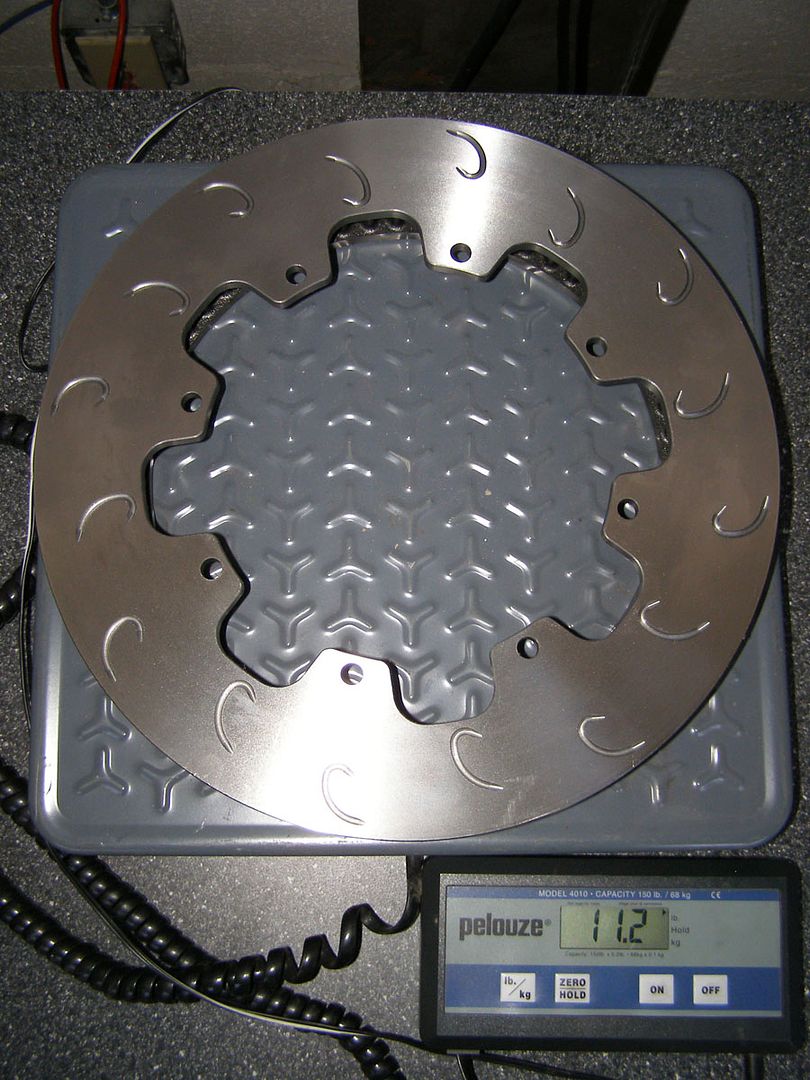
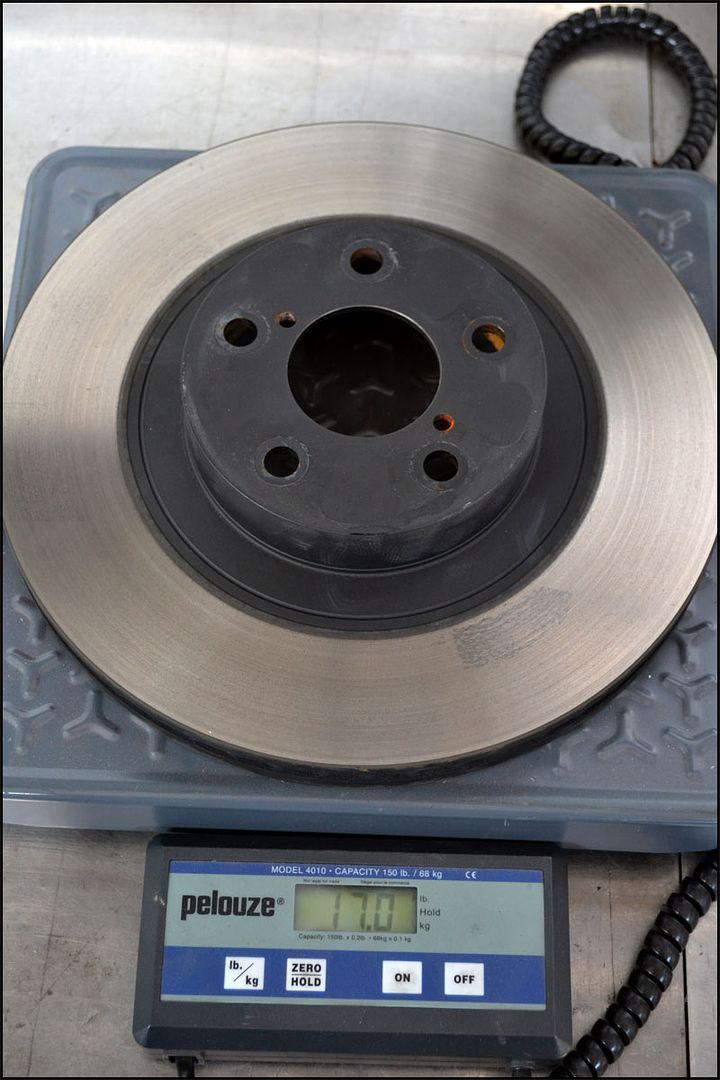
Two-piece Design with Aluminum Hat
For our Sprint Competition package, the discs are fix mounted/bolted
to the aluminum hats. The bolted hat doesn't make any noise or rattle,
and would therefore be the ideal choice if NVH is of any concern. It
does not have any float however, and therefore wouldn't be quite as
effective at reducing stress as the floating setup in our Endurance
System. That said, we have many hundreds of our CP3862 discs on Late
Model racecars using a bolted hat, and we never have any reported
problems of stress-related cracking. These cars are 2800 lbs. and
500hp, and stand on their brakes every 7-9 seconds! Therefore, we
certainly don't foresee any problems on the FT86.
The disc hats themselves are manufactured from 2024-T351 heat-treated
billet aluminum, with a hard anodize coating for extra durability.
This material was specifically chosen for its strength at high
temperatures, as it will be in direct contact with the searing hot iron
discs. The hats feature scallops on the underside, to allow for heat
evacuation along the outer disc face once installed.
Exclusive AP Racing J Hook slot pattern
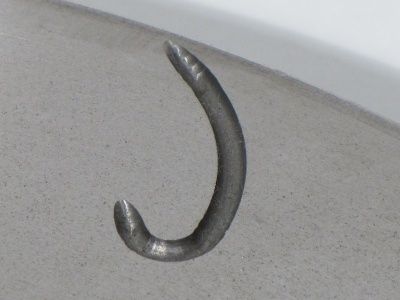
When you cut a slot or drill a hole in a disc you impact heat
transfer. The area around the slot or hole acts as a cool spot when the
disc heats up, which is not ideal. Ideally, heat is distributed
uniformly around the disc so it can be hit with the cooling air that is
pumping through the disc, radiate outwards away from the disc, etc.
Cool spots create stress risers and increase the likelihood of the disc
cracking. They also cause the face of the disc to distort unevenly,
leading to uneven pad deposits, vibration, and judder.
The OEM discs avoid this problem by simply leaving the face blank.
While the risk for NVH goes down, so does the pad bite and feel of the
disc through the brake pedal.
During
exhaustive R&D testing, AP's J Hook design was found to create a
constant pathway of evenly distorted material on the face of the disc.
The hooks are spaced out as evenly as possible both around the
circumference of the disc, as well as from the inside edge (where the
hat attaches) to outer edge, with a slight overlap to promote even heat
distribution/distortion. In addition to reducing cracking, the even
heating of the disc also helps provide an even transfer layer of pad
material on the disc when you bed them in.
Additionally, the J
Hook slot pattern produces a greater number of leading edges for the
pads to bite into vs. a traditional curved slot pattern, and
particularly a plain-faced disc. While this may lead to slightly more
whirring or scraping noises from the discs when applying the brakes, the
benefits of more even heat distribution, less propensity to crack,
cleaner pad material transfer during bed-in, and more bite far outweigh
the slight increase in NVH for the serious enthusiast.
Feature: Complex metallurgy developed through 50+ years of experience
AP Racing has been designing brake components for more than 50
years. They've had their components on cars that have won more than 600
grand prix's (Formula 1). On any given race weekend, AP J Hook discs
can be found on 75% or more of the NASCAR Sprint Cup grid. AP has
learned from these experiences, and have developed a proprietary iron
alloy with extreme durability, designed specifically for what you intend
to do with it (flog the hell out of it).
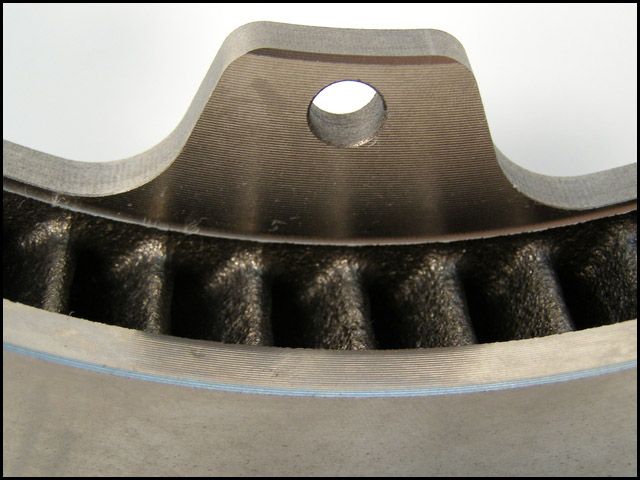
Reasonable replacement cost
Let's face it, no matter how good a brake disc is, it's still a
consumable item. They're no different than brake pads or gasoline. You
beat them up until they crack to pieces, then you throw them away. If
replacement iron is too expensive, you're always driving in fear,
waiting to shell out big bucks for a new set. Despite having the most
expansive set of features on the market, the 299x32mm Heavy Duty J
Hook's retail for a budget-friendly $158 each.
Going to the track is expensive! Event entrance fees, hotels, fuel,
and tires all add up. While you obviously want the best product
available, you can't afford to pay a small fortune for something you're
just going to destroy. You can buy a set of cheap, heavy, OEM-style
repalcement discs every so often, but you're much more likely to have
heat-related brake issues, and you'll find yourself swapping them out
much more frequently. When you do the math, the long-term value of the
AP J Hook's is tough to beat. You'll enjoy all the benefits without
breaking the bank, and you'll spend more time driving and less time
wrenching.
Elite level teams choose AP Racing discs because they know the work
has been done to provide the best available product at any price level.
The AP Heavy Duty J Hook is a direct derivative of AP's vast racing
experience. You can buy with confidence knowing that you're getting the
best product available at any price point. A note of caution however:
the J Hook design is often imitated, and there are a number of lesser
quality imitations on market. Before purchasing, make sure you are
getting an authentic AP Racing J Hook!
Caliper Brackets & Hardware
Caliper brackets for our kit are machined from heat-treated 6061 T6
billet aluminum, and hard anodized, ensuring strength and durability.
All included socket head bolts are a high tensile strength steel. One
of the nice features of our brackets is their cutaway design, which
allows for the snug fitment of many currently available brake duct kits.
Brake Ducting
Depending on your setup, brake ducts may be beneficial. However, great care should be taken when installing a duct kit. To ensure proper alignment of the caliper on the car, nothing should ever be bolted between the caliper bracket and the upright!
Spiegler Stainless Steel Brake Lines
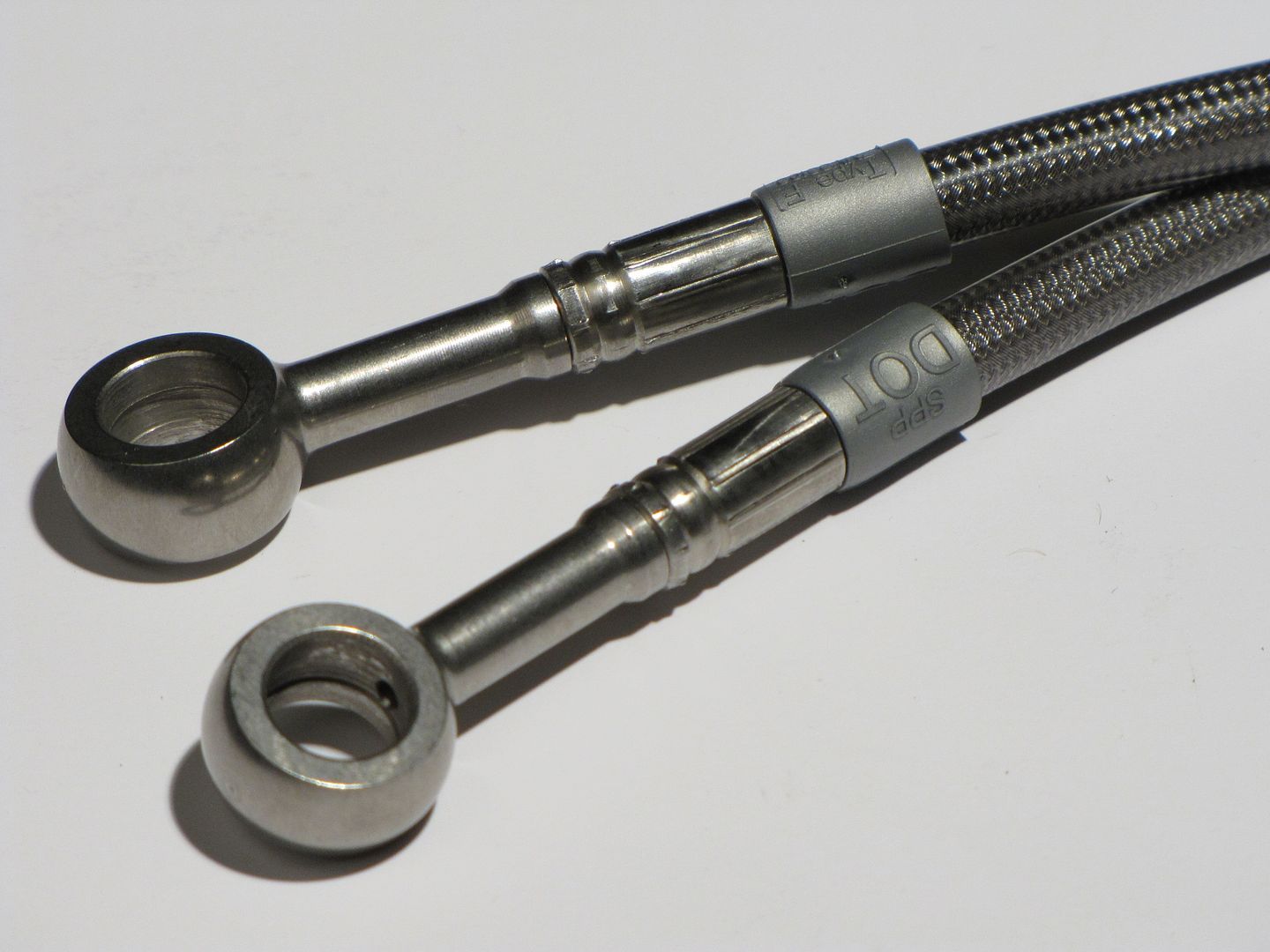
For our FT86 system, Essex is including a pair of the highest quality
brake lines currently available. These lines have a wide range of
features not available in competitive offerings (see below). For
complete details please visit the Spiegler page on our site. Also, matching Spiegler rear BRZ lines are available.
|
Feature
|
Benefit
|
|
All components manufactured in USA and Europe
|
Stringent and consistent quality control
|
|
Stress-free Torsion Fitting System
|
Allows 360 degree rotation of banjo fitting for correct alignment and strain reduction
|
|
Abrasion resistant coating/sheath
|
Eliminates snagging and chafing
|
|
Aircraft quality stainless steel fittings and bolts
|
Superior strength, longevity, and safety
|
|
Heavy gauge, tightly woven stainless steel braid
|
Eliminates line swell, more consistent feel
|
|
Du Pont PTFE- Teflon® lining
|
Reduces line expansion and provides greater durability
|
|
DOT compliant
|
Quality assurance, road legal
|
|
Wide range of colors
|
Allows for personalization
|
|
Standard and custom designs shipped in 48 hours
|
No more waiting around for lines to show up
|
|
Full testing battery on all parts, with lifetime warranty
|
Purchase and drive with confidence
|
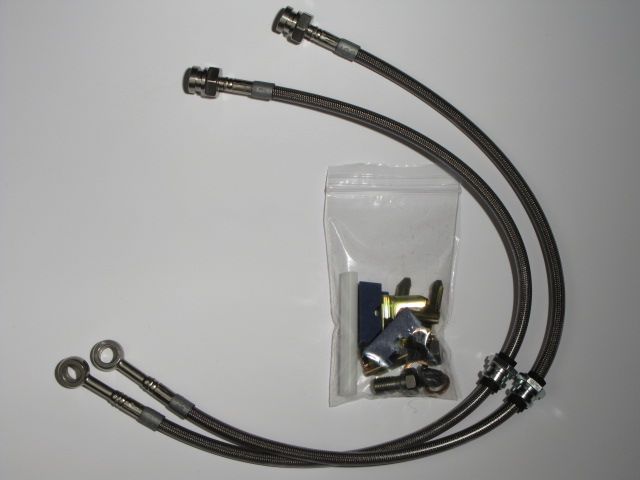
Summary and Conclusion
Based on everything we’ve learned during development, we believe our
system offers our customers the following advantages over the OEM BRZ /
FR-S / GT86 brake system:
- 10 lbs. unsprung weight reduction from both front corners of the
car. Twenty lbs. total are removed from the nose of the car, improving
front to rear weight balance.
- Incredible array of inexpensive race pad options at prices that are
substantially lower per set than the OEM pad shape. The 20mm pads are
50% thicker than stock, providing far greater wear resistance and
insulation for your calipers.
- Extremely compact package for low moment of inertia, lowest possible weight, and superior wheel fitment
- High airflow, heavy duty AP Racing J Hook brake discs that are
substantially lighter than the OEM units, available at an extremely
competitive replacement price ($158 each).
- Disc metallurgy specifically designed to handle the temps typically
seen on track offers a long service life, and low long-term running
costs
- Stainless steel pistons that keep heat out of your brake fluid to resist fluid fade during extended track sessions
- Mitigation of pad knockback due to 4lb. anti-knockback springs in the calipers
- Less chance of damaging bleed screws or crossover tubes when changing wheels due to built-in protection
- Anodized caliper finish that is more resistant to wear and deterioration
- Stainless steel caliper hardware for a long caliper service life under frequent pad change conditions
- High temperature, low drag seals that will hold up to track temps
better than OEM components= less rebuilding and longer service life
- No dust boots to burn up and make a big mess
- Simple pad change with one bolt
- Lifetime professional caliper rebuilding support by Essex (at a
fee)- pull off your calipers, send them to us, we clean, inspect, and
rebuild them
- AP Racing J Hook slot design that gives more pad bite/feel, and distributes heat evenly throughout the disc
- Highest quality, Spiegler stainless steel brake line with clear sheath that reduces compliance over OEM rubber design.
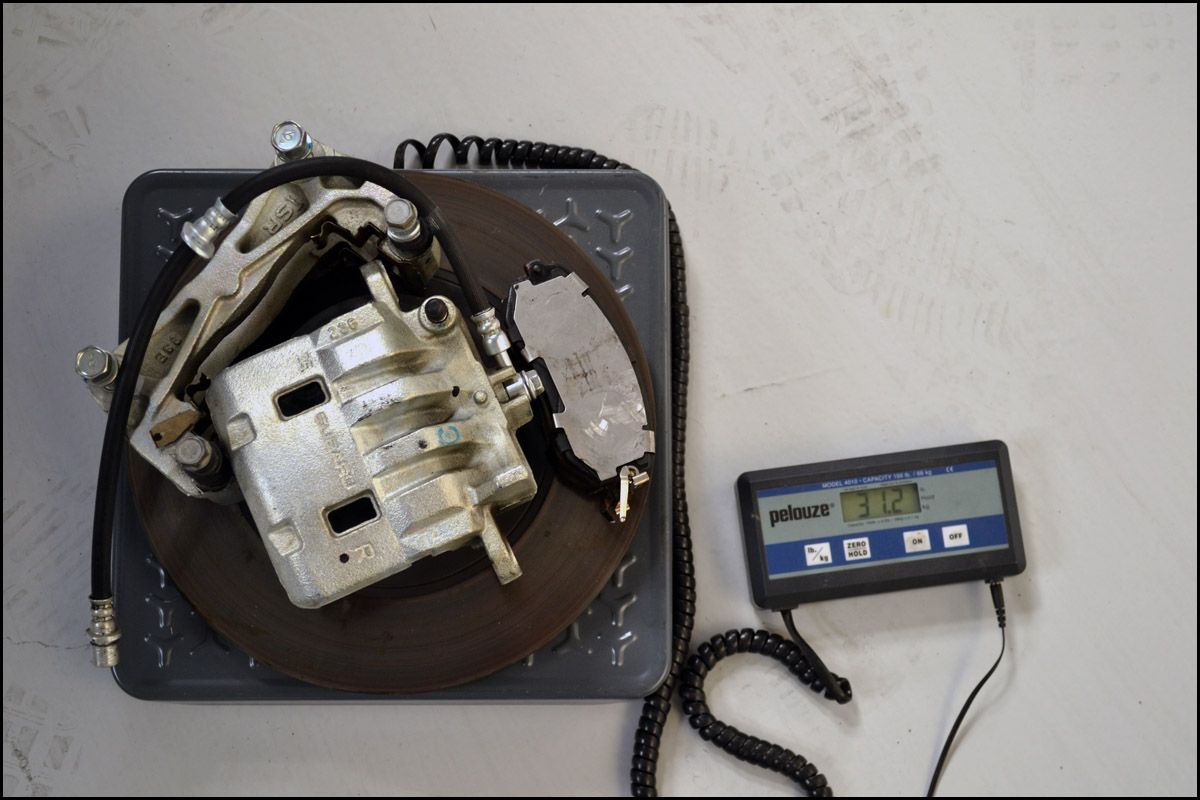
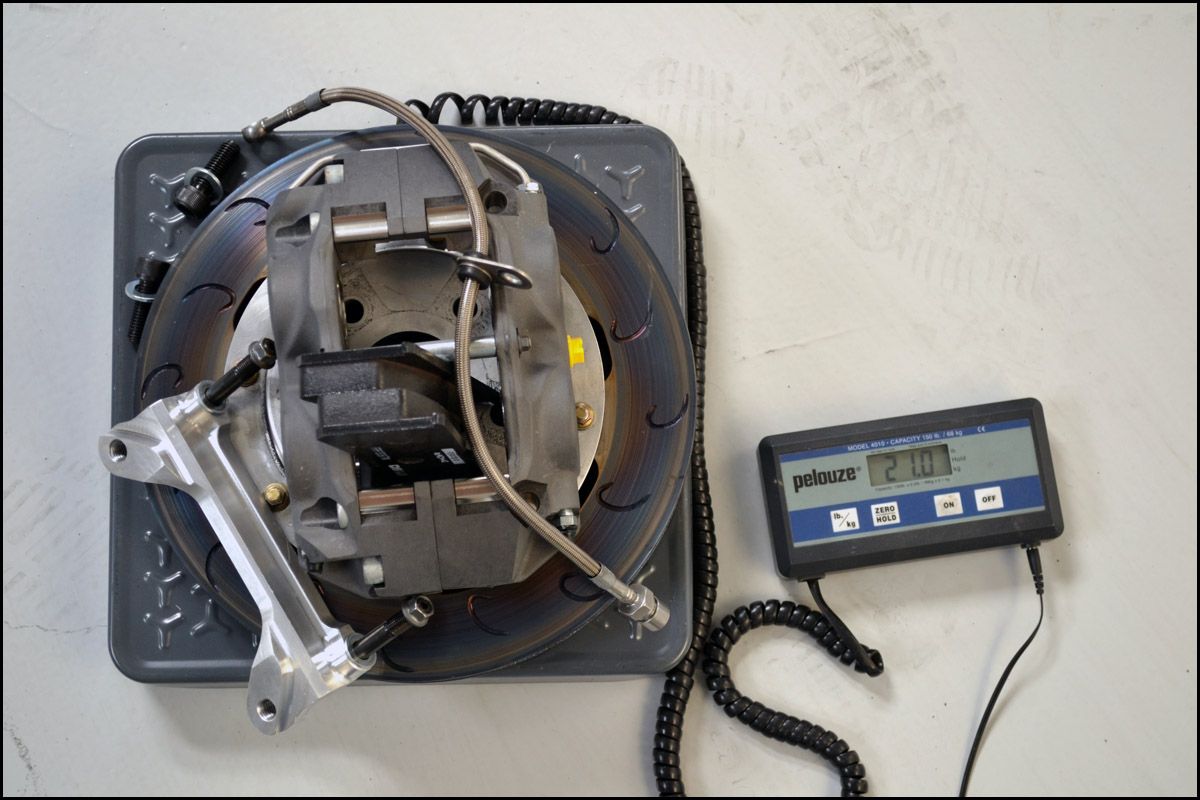
Endurance vs. Sprint System Comparison
- Sprint system is roughly 10 lbs. lighter per corner than stock,
while Endurance system is approximately 5 lbs. lighter per corner than
stock
- Endurance System comes with built-in provision for connecting brake ducts
- Endurance system uses slightly larger disc, with a higher internal vane count
- Aluminum hats on Endurance discs are floating, while hats on Sprint discs are bolted
- Actual disc metallurgy the same for both kits, although spare discs
for Sprint system are about $100 cheaper (each)...$200 less for the
pair.
- Slightly taller pads can be used on the Endurance package, giving
greater pad volume and longer wear characteristics
- Any pad that works in the Sprint System will also work in the Endurance package
- Both kits will fit under certain 17" wheels, but neither will fit
OEM wheels without a spacer. Wheel fitment templates available on our
site.
Differences are in bold below:
|
Essex FT86 Competition Brake System Comparison Grid
|
|
Endurance System
|
Sprint System
|
|
$2,599.00
|
$2,099.00
|
|
Total system weight savings vs. OEM= 10 lbs.
|
Total system weight savings vs. OEM= 20 lbs.
|
|
Weight savings per front corner vs. OEM= 5 lbs.
|
Weight savings per front corner vs. OEM= 10 lbs.
|
|
|
|
|
AP Racing CP3908 Disc
|
AP Racing CP3862 Disc
|
|
325mm x 32mm
|
299mm x 32mm
|
|
70 Directional Vanes
|
60 Directional Vanes
|
|
J Hook Slot Pattern
|
J Hook Slot Pattern
|
|
Fully floating
|
Fixed mount
|
|
Crack-resistant metallurgy
|
Crack-resistant metallurgy
|
|
Approximate weight with hat= 17.6 lbs.
|
Approximate weight with hat= 12.2 lbs.
|
|
Spares Price= $249 per iron replacement disc
|
Spares Price= $158 per iron replacement disc
|
|
|
|
|
Brake pad maximum radial depth 50mm
|
Brake pad maximum radial depth 43mm
|
With either of our systems, Essex recommends upgrading your rear
brake pads to the same or similar pad compound to what you will be
running in the front. Doing so will help provide the appropriate brake
bias, ABS integration, and feel that our customers expect under heavy
braking loads on the track.
If you have any uncertainty as to which system will be the best fit
for your needs, please don't hesitate to call us. That's why we're
here! As a general rule, if you plan to keep your car at relatively
stock power levels, the Sprint System should be more than ample for your
needs (even if you are running bigger, sticky tires, and have reduced
your curb weight). The Sprint System has the lower weight of the two
options, and also the least expensive consumable costs. If you plan
to add big power via a turbo or supercharger, plan to compete in
Endurance racing, or just want something to further fill up your
wheels, then the Endurance System may be a good starting point for
you. The Endurance system should provide everything anyone would
ever want or need for tracking this platform. They actually have a 637
whp Lancer Evo heavily tracking the Endurance System without issue!
Details:
- Fits 2013 Scion FR-S and Subaru BRZ.